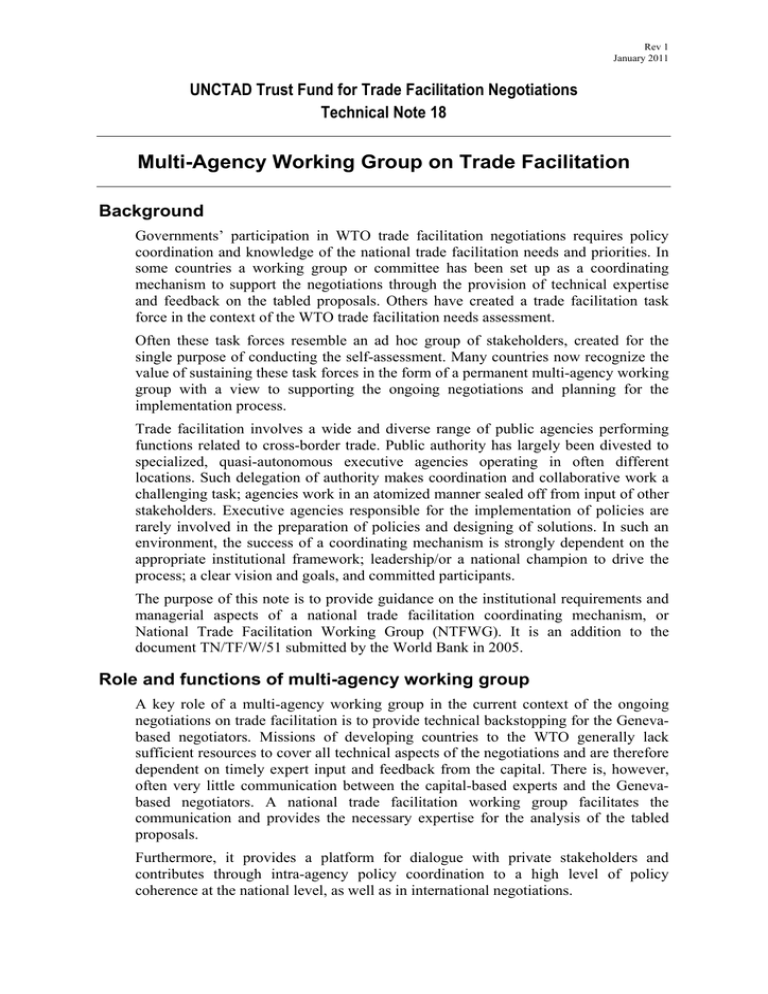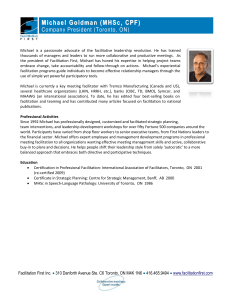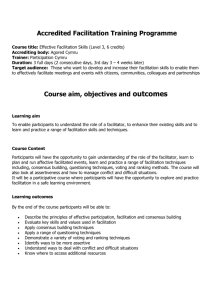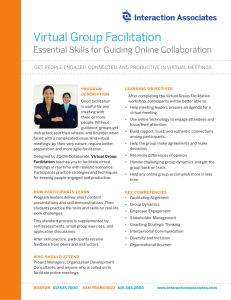Multi-Agency Working Group on Trade Facilitation Technical Note 18 Background
advertisement

Rev 1 January 2011 UNCTAD Trust Fund for Trade Facilitation Negotiations Technical Note 18 Multi-Agency Working Group on Trade Facilitation Background Governments’ participation in WTO trade facilitation negotiations requires policy coordination and knowledge of the national trade facilitation needs and priorities. In some countries a working group or committee has been set up as a coordinating mechanism to support the negotiations through the provision of technical expertise and feedback on the tabled proposals. Others have created a trade facilitation task force in the context of the WTO trade facilitation needs assessment. Often these task forces resemble an ad hoc group of stakeholders, created for the single purpose of conducting the self-assessment. Many countries now recognize the value of sustaining these task forces in the form of a permanent multi-agency working group with a view to supporting the ongoing negotiations and planning for the implementation process. Trade facilitation involves a wide and diverse range of public agencies performing functions related to cross-border trade. Public authority has largely been divested to specialized, quasi-autonomous executive agencies operating in often different locations. Such delegation of authority makes coordination and collaborative work a challenging task; agencies work in an atomized manner sealed off from input of other stakeholders. Executive agencies responsible for the implementation of policies are rarely involved in the preparation of policies and designing of solutions. In such an environment, the success of a coordinating mechanism is strongly dependent on the appropriate institutional framework; leadership/or a national champion to drive the process; a clear vision and goals, and committed participants. The purpose of this note is to provide guidance on the institutional requirements and managerial aspects of a national trade facilitation coordinating mechanism, or National Trade Facilitation Working Group (NTFWG). It is an addition to the document TN/TF/W/51 submitted by the World Bank in 2005. Role and functions of multi-agency working group A key role of a multi-agency working group in the current context of the ongoing negotiations on trade facilitation is to provide technical backstopping for the Genevabased negotiators. Missions of developing countries to the WTO generally lack sufficient resources to cover all technical aspects of the negotiations and are therefore dependent on timely expert input and feedback from the capital. There is, however, often very little communication between the capital-based experts and the Genevabased negotiators. A national trade facilitation working group facilitates the communication and provides the necessary expertise for the analysis of the tabled proposals. Furthermore, it provides a platform for dialogue with private stakeholders and contributes through intra-agency policy coordination to a high level of policy coherence at the national level, as well as in international negotiations. In view of the implementation of the negotiated commitments, its experts can provide necessary input for the development of operational and strategic solutions and the designing of an implementation plan, taking into account broader trade facilitation reform objectives. Implementation issues The complex institutional setting of multiple agencies having responsibilities with regards to cross-border trade and transit of goods makes intra-agency coordination a challenging task. Agencies operate in an atomized manner and lack the experience and structure for collaboration. Conflict over resources and mandates between the different ministries, departments and agencies typically characterize the trade facilitation policy environment. Private sector consultation is often limited to ad hoc information and briefing sessions on the occasion of the introduction of new or amended legislation and procedures. When considering setting up a working group as a coordinating mechanism one has, therefore, not only to look at the institutional arrangements of the working group, but also the managerial aspects of its daily operations. A clear institutional framework defining the role and responsibilities of the working group, strong leadership, clearly defined vision and goals, as well as committed participants, are key elements for the sustainability of trade facilitation working groups. Institutional framework The establishment of the institutional arrangements for the coordinating mechanism is critical to its success and sustainability. The specific institutional arrangements for the multi-agency coordinating mechanism on trade facilitation would vary from country to country with regards to the mandate and resources and decision-making power attributed to them. Working groups could be formalized with a clear mandate endorsed by the government or operate in an informal, consultative ad hoc manner. Whilst some may be given key decisionmaking powers, others may function as an expert advisory body only. There is no prescriptive structure and role for a working group. The role and tasks of the working group need to be integrated into the national economic policymaking and aimed at contributing to the effective delivery of national development and reform efforts. Trade facilitation is only one of the many strategic development goals of a country and is closely linked to broader public policy objectives, including, inter alia, Customs modernization, public sector reform and export promotion. The functions and responsibilities of the working group should be defined in its terms of reference and mandate. Key elements of the terms of reference are the line of communication and reporting to existing governmental institutions, and the type of outcomes expected from the working group. The terms of reference, therefore, determine how much control over resources is attributed to the group and how the working group is linked to the executive and the government in general. It may, furthermore, be necessary to attribute responsibility for the working group to one particular administration. If the working group is established as a permanent body, a coordinator should support its functions. The role of the coordinator should extend to performing secretarial functions, including setting meeting schedules, preparing the agenda, keeping records -2- and minutes of meetings and circulating information to members. The coordinator can be appointed or elected based on the terms of reference agreed by the body. It is recommended that the choice of coordinator should be one agreed upon by stakeholders, in order that the legitimacy of the functionary is established. In order to perform the task of coordinator, the requisite tools and resources should be made available to the functionary. Regularity of meetings and good record keeping help keep the group motivated. Leadership and urgency Institutional arrangements, however, are not the key factor for success of a multiagency working group. In addition, appropriate leadership is necessary, in particular, in the process during the establishment of the working group. At the outset the role out of the group is aided by a strong leader, sometime referred to as a champion. This individual would stimulate interest in the group and generate awareness of the importance of establishing the working group. In addition to stimulating interest, the role of the champion would include selling the vision and benefits of the trade facilitation working group (TFWG) to the political establishment and key social and economic actors. The leader in this context is required to be proactive, committed to the task in a nearly ideological manner – similar to that of an entrepreneur. Leadership is demonstrated by the very act of a willingness to guide the process, and is recognized because of formal or informal authority provided by acknowledged competence, access to the political establishment, and the capacity to mobilize. There are, however, conditions that support the emergence of leadership, such as a perceived sense of urgency to act and the expectations of benefits to be gained for interested parties. The urgency to implement trade facilitation reform is related to a country’s desire to reduce trade costs and enhance trade efficiency and ultimately national trade competitiveness. Evidence gathered through benchmarking studies and trade facilitation audits can be used to underscore the need to act upon the observed trade facilitation challenges. If the TFWG proves to be a successful agent of reform, its leadership will receive recognition, resources and authority for implementation. This motivates its leaders and members for their work. The negotiations on trade facilitation at the WTO also have an important role for mobilizing support for the TFWG. Against the background of the ongoing negotiations, trade facilitation has been identified as a key factor for economic development and in some cases, regional integration. An initial impulse and strong leadership throughout are crucial for guiding the work of the TFWG and encouraging members to achieve the goals of the group. A mission statement and a work plan are tools needed to facilitate the successful accomplishment of tasks by members of the group. Mission statement, objectives, work plan and achievements The development of a mission statement is important to the identification of a common objective and to reflect the collective aspirations of the group. The mission statement should be phrased in a simple sentence which is easy to communicate and understand. -3- Objectives and goals define, in more detail, the work of the task force over a specific timeframe. In this context, objectives of the TFWG should be broad and continuous to remain flexible and subject to re-evaluation over time. Goals, as contrasted with objectives, are measurable targets to be achieved within identified timeframes. They can be short or long-term. Actions or tasks will be defined against the specific goals. The work plan links objectives to goals and spells out what actions will be carried out. It should also contain the required actions, measurable goals, expected timeframe and should designate individual or subcommittees based on demonstrated competences to carry on these specific responsibilities. Trade facilitation is a large policy field, necessitating interventions in many distinct areas, such as: Customs (modernization), strengthening enforcement (transparency and oversight), e-government, logistics, transport infrastructure and simplifying trade procedures. The ongoing negotiations at the WTO and regional economic integration processes provide for an additional layer of complexity. The TFWG group should take a pragmatic approach to the development of a work programme. There is the danger of setting the objectives too high. Rather, it is important to set achievable objectives and goals with short-term and long-term time frames which are reflective of the groups’ resources and decision-making power vested to the group. Ideally, a group such as the TFWG contributes to and, where possible, initiates policy change. In this context, the TFWG would function at all levels of the policy cycle, from problem identification to the development of solutions and the delivery. Within this broader context, many different targeted objectives can exist, ranging from strategic to operational goals. Operational objectives are very powerful in persuading decision-makers, and members alike, that the TFWG leads to concrete accomplishments. Strategic objectives aim at influencing the policy process and directing it towards the implementation of necessary policy reforms. The performance and recognition of the working group itself should also be included in the objectives. Developing and maintaining a viable network with the government and ensuring successful follow-up of the groups’ decision require attention and resources of the group. It is highly recommended to include the working group in determining the objectives, the work plan and the mission statement, through e.g. joint brainstorming sessions. This ensures a high level of ownership and buy-in over the process by the membership and results in a greater level of commitment on the part of the members of the working group. Committed participants As noted above, ensuring a broad, multi stakeholder participation in the TFWG is critical to success. All relevant actors and stakeholders should be brought into the process. An inclusive structure is important for the legitimacy of, and support to the working group. However, it requires time and effort to establish a work environment of trust and transparency. Trade facilitation stakeholders comprise a diverse group of public agencies and representatives from the trading community. The following is an indicative list of agencies and organizations that are typically involved in cross-border trade issues and could be invited to become members of the TFWG. The name and responsibilities of the listed agencies may vary from country to country: -4- • Implementing agencies: (Customs, Quarantine, Standards Board, Port Authority and Airport Authority, etc.); • Attorney General or Legal Department of Cabinet (legal matters, e.g., appeals); • Line Ministries for Transport, Commerce, Foreign Affairs, Economy and Finance , Agriculture and Animals, Food and Drugs, and Environment; • Private sector: a cross-section to reflect wide interests, including large and small, importers and exporters, carriers, freight forwarders and associations, cargo owners, chambers of commerce and shippers associations). Representatives on the TFWG should come from different functional levels, including executive and non-executive directors and technical staff. It is important, and requires time, to create an open environment of transparent collaboration based on contributions of each of the members. Different collaborative techniques exist allowing for different contributions and level of engagements, e.g. focus groups or citizen panels. Members of the task force can thus be involved at a level of engagement that takes account of their time limitations and interests. Participants have to be encouraged to take ownership of actions, and receive recognition for accomplishments. In addition to taking on board the contributions of members of the working group, the tasks set out in the work plan should be distributed in a manner that spreads responsibility amongst all represented agencies. It is recommended that, at each meeting, time should be devoted to reporting on progress made on delegated tasks. Likewise, members should share with the group problems encountered so that broader lessons can be drawn and used for the implementation of future tasks. Members have to be able to see that the working group adds value commensurate to the amount of time they dedicate to its work. In this regard, measurable short-term goals provide the impression of quick-wins, and act as a strong motivation for members to become engaged with the working group and take over responsibilities for tasks. Steps to setting up a trade facilitation working group Taking into account the different elements described above, setting up a trade facilitation working group follows a step-by-step process outlined below: -5- For those countries interested in strengthening their existing national coordinating mechanism following the WTO national self-assessment, the starting point would be the institutionalization of the group. The existing institutional framework for trade policy coordination and trade policy reform into which the trade facilitation working group would integrate has to be analysed before drafting the terms of reference and putting them forward for endorsement by the executive and cabinet. The next important step is to establish a working plan and set achievable goals, bearing in mind the importance of realizing quick and tangible accomplishments. The group could either start with limited objectives focusing on the WTO negotiations or from the outset, setting objectives that fall within the broader agenda of trade facilitation reform. Guides and recommendations UN/CEFACT United Nations Centre for Trade Facilitation and Electronic Business (UN/CEFACT) Recommendation No.4 second edition National Trade Facilitation Bodies (ECE/TRADE/242, Geneva 2001). UN/CEFACT Guidelines to recommendation No. 4. Creating an efficient environment for trade and transport. (ECE/TRADE/256, Geneva 2000). The World Bank Trade Facilitation Negotiations Support Guide published as TN/TF/W/51. UNCTAD UNCTAD Trade Facilitation Handbook Part I. National Trade Facilitation Bodies: Lessons Learned (Geneva 2005). References UN/CEFACT United Nations Centre for Trade Facilitation and Electronic Business (UN/CEFACT) Recommendation No.4 second edition National Trade Facilitation Bodies (ECE/TRADE/242, Geneva 2001); and UN/CEFACT Guidelines to recommendation No. 4. Creating an efficient environment for trade and transport. (ECE/TRADE/256, Geneva 2000) The World Bank Trade Facilitation Negotiations Support Guide published as TN/TF/W/51 UNCTAD UNCTAD Trade Facilitation Handbook Part I. National Trade Facilitation Bodies: Lessons Learned (Geneva 2005). Further Technical Notes are available via http://www.unctad.org/technicalnotes. The Technical Notes have been produced by technical experts contracted by UNCTAD within the Trust Fund project “Capacity building in developing countries and least developed countries to support their effective participation in the WTO Negotiations Process on trade facilitation”, financed by the Governments of Sweden and Spain. Their purpose is to assist Geneva- and capital-based negotiators to better understand the scope and implications of the various trade facilitation measures being proposed in the context of multilateral negotiations on trade facilitation. The opinions expressed in the Technical Notes may not necessarily coincide with those of the organization or the donors of the Trust Fund. For comments and enquiries please contact trade.logistics@unctad.org. All Technical Notes are available via http://www.unctad.org/technicalnotes. -6-
![Template for case studies on [Country] - Status [Month] [Year]](http://s2.studylib.net/store/data/010389880_1-c74c4455e06978d6d6860e2af1e506ff-300x300.png)



